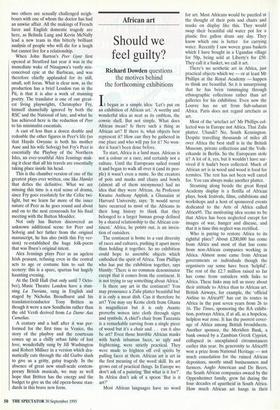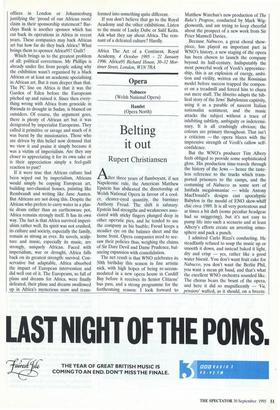African art
Should we feel guilty?
Richard Dowden questions the motives behind the forthcoming exhibitions
It began as a simple idea: 'Let's put on an exhibition of African art.' A worthy and wonderful idea as neat as its emblem, the cowrie shell. But not simple. What does African mean? Is there such a thing as African art? If there is, what objects best represent it? How can they be gathered in one place and who will pay for it? No won- der it hasn't been done before.
To start, Africa is a land mass. African is not a colour or a race, and certainly not a culture. Until the Europeans sailed round it and began to walk all over it (and its peo- ple) it wasn't even a name. So the creators of pots and masks and chairs and bowls (almost all of them anonymous) had no idea that they were African. As Professor Kwame Anthony Appiah, a Ghanaian at Harvard University, says: 'It would never have occurred to most of the Africans in their long history to think that they belonged to a larger human group defined by a shared relationship to the African con- tinent.' Africa, he points out, is an inven- tion of outsiders.
The continent is home to a vast diversity of races and cultures, pushing it apart more than holding it together. So no exhibition could hope to assemble objects which embodied the spirit of Africa. Tom Phillips who has put the exhibition together, says bluntly: 'There is no common denominator except that it comes from the continent. It is not trying to say something about Africa.'
Is there any art in the continent? You may pronounce a Zulu platter beautiful but it is only a meat dish. Can it therefore be art? You may say Kente cloth from Ghana is magnificent but it is only Asante proverbs woven into cloth through signs and symbols. A chiefs chair from Tanzania is a remarkable carving from a single piece of wood but it's a chair and. . . can it also be art? Even those horrible African masks with harsh inhuman faces, so ugly and frightening, were strictly practical. They were made to frighten off evil spirits by pulling faces at them. African art is art in the first meaning of the word: skill. Its art grows out of practical things. In Europe we don't ask of a painting 'But what is it for?'. In Africa don't ask of a spoon 'But is it art?'
Most African languages have no word for art. Most Africans would be puzzled at the thought of their pots and chairs and masks on display like this. They would swap their beautiful old water pot for a plastic five gallon drum any day. They know which one is better for carrying water. Recently I saw woven grass baskets which I have bought in a Ugandan village for 50p, being sold at Liberty's for £50. They call it a basket, we call it art.
There's no aesthetic art in Africa, just practical objects which we — or at least Mr Phillips at the Royal Academy — happen to think are beautiful. So it is unsurprising that he has been rummaging through ethnographic collections rather than art galleries for his exhibition. Even now the Louvre has no art from Sub-saharan Africa. Paris does not regard artefacts as art.
Most of the 'artefact art' Mr Phillips col- lected was in Europe not Africa. That Ztilu platter. Ulundi? No, South Kensington. Despite travelling thousands of miles all over Africa the best stuff is in the British Museum, private collections and the Volk- erkunde in Berlin. So the Europeans stole it? A lot of it, yes, but it wouldn't have sur- vived if it hadn't been collected. Much of African art is in wood and wood is food for termites. The rest has not been well cared for. You can always make another platter.
Steaming along beside the great Royal Academy display is a flotilla of African plays, book festivals, films, exhibitions and workshops and a host of sponsored events dedicated to the Arts of Africa called Africa95. The motivating idea seems to be that Africa has been neglected except for images of war, hunger and disease, and that it is time this neglect was rectified.
Who is paying to restore Africa to its rightful place? About £200,000 has come from Africa and most of that has come from non-African companies working in Africa. Almost none came from African governments or individuals though the organisers say some have been 'helpful'. The rest of the £2.7 million raised so far has come from outsiders with links to Africa. These links may tell us more about their attitude to Africa than to African art. British Airways, for example, the 'official Airline to Africa95' has cut its routes in Africa in the past seven years from 26 to 16. The Times, sponsoring the RA exhibi- tion, portrays Africa, if at all, as a hopeless, helpless war zone. It has the poorest cover- age of Africa among British broadsheets. Another sponsor, the Meridien Bank, a bank owned by a Zambian Greek Cypriot, collapsed in unexplained circumstances earlier this year. Its generosity to Africa95 won a prize from National Heritage — not much consolation for the ruined African depositors, mostly small businessmen and farmers. Anglo American and De Beers, the South African companies owned by the Oppenheimer family, grew fat during the four decades of apartheid in South Africa. How much African art hangs in their offices in London or Johannesburg justifying the 'proud of our African roots' claim in their sponsorship statement? Bar- clays Bank is another sponsor which has cut back its operations in Africa in recent years. These companies may back African art but how far do they back Africa? What brings them to sponsor Africa95? Guilt?
Which brings us to the greatest problem of all: political correctness. Mr Phillips is already under fire from people asking why the exhibition wasn't organised by a black African or at least an academic specialising in African art. But it runs deeper than that. The PC line on Africa is that it was the Garden of Eden before the Europeans pitched up and ruined it. Since then every- thing wrong with Africa from genocide in Rwanda to drought in Sudan, is blamed on outsiders. Of course, the argument goes, there is plenty of African art but it was denigrated by imperialist Europeans. They called it primitive or savage and much of it was burnt by the missionaries. Those who are driven by this belief now demand that we view it and praise it simply because it was a victim of imperialism. Are they any closer to appreciating it for its own sake or is their appreciation simply a feel-guilt reaction to past?
If it were true that African culture had been wiped out by imperialism, Africans would simply be copying European art, building neo-classical houses, painting like Rembrandt and writing like Jane Austen. But Africans are not doing this. Despite the African who prefers to carry water in a plas- tic drum rather than an earthenware pot, Africa remains strongly itself. It has its own way. The fact is that Africa survived imperi- alism rather well. Its spirit was not crushed, its culture and society, especially the family, remain as strong as ever. Its novels, sculp- ture and music, especially its music, are strongly, uniquely African. Faced with imperialism, war or drought, Africa falls back on its greatest strength: survival. Con- servative but adaptable, Africa absorbed the impact of European intervention and did well out of it. The Europeans, so full of plans and dreams for Africa, were finally defeated, their plans and dreams swallowed up in Africa's mysterious maw and trans- formed into something quite different.
If you don't believe that go to the Royal Academy and the other exhibitions. Listen to the music of Lucky Dube or Salif Keita. Ask what they say about Africa. The rem- nant of a defeated culture? Hardly.
Africa The Art of a Continent, Royal Academy, 4 October 1995 - 21 January 1996. Africa95 Richard House, 30-32 Mor- timer Street, London, W1N 7RA.



































































 Previous page
Previous page